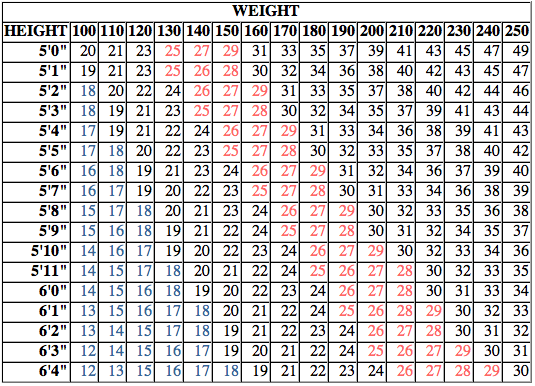Body Mass Index (BMI) is a helpful tool for men to assess their weight in relation to their height. It’s a simple calculation that can provide valuable insights into your health status.
A BMI calculator for men uses your height and weight to determine if you’re in a healthy weight range.
While BMI isn’t perfect, it’s widely used by healthcare professionals as a quick screening method. For adult men, a normal BMI falls between 18.5 and 24.9. Values above or below this range may indicate potential health risks.

Knowing your BMI can motivate you to make positive lifestyle changes if needed. It’s important to remember that BMI is just one piece of the health puzzle. Other factors like muscle mass, body composition, and overall fitness also play crucial roles in determining your health status.
Key Takeaways
- BMI provides a quick assessment of weight status based on height and weight
- A normal BMI for adult men ranges from 18.5 to 24.9
- BMI should be used alongside other health indicators for a comprehensive evaluation
Understanding BMI
Body Mass Index (BMI) is a widely used tool to assess body composition. It helps estimate body fat and potential health risks based on height and weight. Let’s explore the concept and interpretation of BMI values.
The Concept of BMI
BMI is a simple calculation that uses a person’s weight and height. We divide weight in kilograms by height in meters squared to get the BMI value.
For example, a man weighing 80 kg and standing 1.8 meters tall has a BMI of 24.7.
The BMI formula is straightforward but doesn’t account for muscle mass or body fat distribution. It’s a quick screening tool, not a diagnostic measure.
BMI works best for average adults and may be less accurate for athletes or older individuals.
Despite its limitations, BMI remains useful for population-level health assessments. It’s easy to calculate and doesn’t require special equipment.
Interpreting BMI Values
BMI values fall into different categories that indicate potential health risks. The standard BMI ranges for adults are:
- Underweight: Below 18.5
- Normal weight: 18.5 to 24.9
- Overweight: 25 to 29.9
- Obese: 30 or higher
These categories help identify possible weight-related health issues. A high BMI may suggest increased risk for conditions like heart disease or diabetes. A very low BMI could indicate malnutrition.
It’s important to note that BMI is just one factor in assessing health. We should consider other measures like waist circumference and body fat percentage for a more complete picture.
BMI Calculation for Men
Body Mass Index (BMI) is a useful tool for assessing weight status in men. We’ll explore how BMI is specifically applied to men and the methods used to calculate it.
Specifics of BMI for Men
BMI ranges for men are the same as for women, but there are some key differences. Men typically have more muscle mass and less body fat than women at the same BMI. This means a man with a BMI of 25 might be less overweight than a woman with the same BMI.
- Under 18.5: Underweight
- 18.5 to 24.9: Normal weight
- 25 to 29.9: Overweight
- 30 and above: Obese
It’s important to note that BMI doesn’t distinguish between muscle and fat. A muscular man might have a high BMI but not be overweight.
BMI Calculation Methods
We use a simple formula to calculate BMI for men. The standard method is:
BMI = weight (kg) / height² (m²)
For those using pounds and inches, the formula is:
BMI = (weight (lbs) * 703) / height² (inches²)
Many online calculators can quickly determine BMI. These tools often provide additional information like weight category and healthy weight range.
Some advanced BMI calculators for men take into account factors like age and body frame size. These can provide a more accurate assessment of a man’s ideal weight range.
Importance of Accurate Measurement
Precise measurements are crucial for calculating BMI correctly. Inaccurate data can lead to misleading results and potentially incorrect health assessments.
Measuring Weight and Height Accurately
To get an accurate weight, we recommend using a calibrated digital scale. It’s best to weigh yourself in the morning, after using the bathroom and before eating or drinking. Wear light clothing and remove shoes.
For height, stand against a flat wall without shoes. Use a fixed measuring tape or a stadiometer. Keep your heels, buttocks, and shoulders touching the wall. Look straight ahead and have someone mark where the top of your head meets the wall.
Accurate measurements are key to a reliable BMI calculation. Even small errors can significantly impact the results.
Impact of Incorrect Measurements
Inaccurate measurements can lead to miscategorization of BMI. This may result in false health assessments and unnecessary worry or complacency.
For example, overestimating height by just one inch can move someone from the “overweight” to “normal” category. Similarly, underestimating weight can mask potential health risks.
Incorrect BMI calculations may lead to inappropriate medical advice or treatment plans. They can also affect insurance premiums or eligibility for certain medical procedures.
We must remember that while BMI is a useful tool, it doesn’t account for muscle mass, bone density, or body composition. Accurate measurements help ensure BMI provides the most useful information possible within its limitations.
Utilizing BMI Information
BMI results offer valuable insights for men’s health management. Proper use of this data can guide lifestyle choices and indicate when professional advice is necessary.
Creating a Health Plan
We recommend using BMI as a starting point for a comprehensive health plan. A BMI calculator for men can provide a baseline measurement. From there, we suggest setting realistic goals for weight management.
It’s important to pair BMI data with other health metrics. We advise tracking changes in muscle mass, waist circumference, and body fat percentage. These additional measures give a more complete picture of overall health.
Diet and exercise are key components of any health plan. We propose tailoring nutrition and physical activity based on BMI category. For example, men with higher BMIs may benefit from increased cardiovascular exercise and reduced calorie intake.
When to Consult a Professional
BMI results outside the normal range often warrant professional guidance. We strongly advise seeking medical advice for BMIs below 18.5 or above 30. These values may indicate potential health risks that require expert assessment.
It’s crucial to consult a healthcare provider if BMI changes rapidly without intentional lifestyle modifications. Unexplained weight loss or gain can signal underlying health issues.
We recommend professional consultation for men struggling to achieve or maintain a healthy BMI. Nutritionists and fitness experts can provide personalized strategies for effective weight management. Regular check-ups with a doctor are essential to monitor BMI trends and overall health status.
Frequently Asked Questions
BMI is a key health indicator for men. It helps assess weight status and potential health risks. Let’s explore some common questions about BMI for males.
How is Body Mass Index (BMI) calculated for men?
BMI for men is calculated by dividing weight in kilograms by height in meters squared. The formula is BMI = weight (kg) / [height (m)]^2.
For those using pounds and inches, multiply weight in pounds by 703, then divide by height in inches squared.
What constitutes a healthy BMI range for adult males?
A healthy BMI range for adult males is between 18.5 and 24.9. This range is associated with lower health risks.
Men with BMIs in this range typically have a balanced weight for their height.
At what BMI is a male considered overweight or obese?
Men are considered overweight when their BMI is between 25 and 29.9. A BMI of 30 or higher indicates obesity.
These categories signal increased health risks and may require lifestyle changes.
Does age affect the BMI range for males, and if so, how?
Age can influence BMI interpretation for males. As men age, they may lose muscle mass and gain fat.
This change can affect BMI accuracy, as BMI doesn’t distinguish between muscle and fat weight.
What is the significance of BMI in assessing men’s health?
BMI helps assess potential health risks in men. It can indicate increased risk for conditions like heart disease and diabetes.
We use BMI as a screening tool, not a diagnostic measure. It guides further health assessments.
How can a man interpret his BMI result and its implications for his health?
A man should view his BMI as one piece of health information. It provides a starting point for discussions with healthcare providers.
We recommend considering BMI alongside other factors like waist circumference, diet, and physical activity levels.

